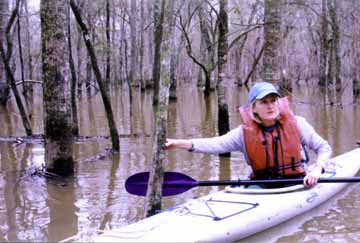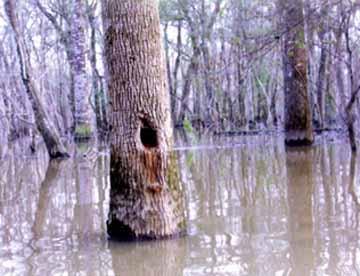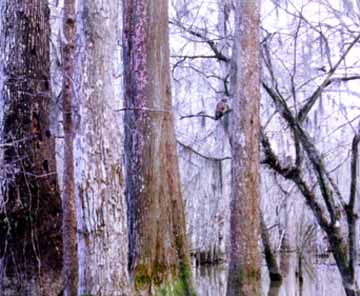Searching for the Elusive Ivory-billed Woodpecker By Glynn Wilson GOAT ISLAND, La., Feb. 2 — Floating along quietly in this cypress swamp only a half-hour's drive northeast of New Orleans and a short canoe trip into the Pearl River Basin, it's not hard to imagine hearing the high-pitched, trumpet-like call of the ivory-billed woodpecker while straining for a glimpse of what may only be a ghost.
"It's definitely the holy grail for birders," said Dr. Paul Wagner, a retired academic now living the life of a tour guide for his Honey Island Swamp Tours company. "They're out there trying to find it. Whether ivory-bills are there or not is a good question worthy of investigation." The ivory-bill is listed as an endangered species but thought to be extinct. That is, until April 1, 1999, when Louisiana State University forestry student David Kulivan says he spotted a pair on a water oak while sitting under a tree, camouflaged, stalking turkey. He insists it's not an April Fools Day joke, and a panel of experts gave his story enough credence to mount an organized search. Somewhere in the labyrinth of cypress swamp, wetlands and bottomland forest in the Pearl River Wildlife Management Area, a team of researchers funded by a German optics company with a U.S. base huddled in their campsite in February trying to think like a very large and possibly extinct bird. A state bunkhouse across the way from Dr. Wagner's headquarters serves as ground-zero in one of the most intensive searches for a potentially extinct species since British zoo owner John Blashford-Snell's 1996 search for a living woolly mammoth in the Himalayas. Dr. James Van Remsen, curator of birds at the Museum of Natural Science at LSU in Baton Rouge, organized the latest search and recruited two world-class birders, a habitat biologist, a couple of doctoral students in biology and a computer scientist/birder. The Odds Dr. Remsen concedes the odds are heavily against the expedition coming away with pictures or video of the ivory-bill, or even sound recordings of its unique nasal call. It would be like finding a dodo bird long after it was declared extinct. "Somebody called this the Ghost Busters of the Southern Forest. We've hired the Ghost Busters and they haven't been able to find it. But we keep hoping," said Gary Lester, director of the Natural Heritage Program for the state Department of Wildlife and Fisheries. Speaking of ghosts, he said, "they haven't found the Honey Island Swamp Monster either, locally as well-known" as the ivory-bill. What would happen if someone spotted a pair of ivory-bills? "I can't imagine it actually happening," Mr. Lester said. "We're out here looking, that's our job, hoping it's actually found. But the likelihood is really low." But, in case the ivory-bill is found, the state fish and wildlife agency is working with the U.S. Fish and Wildlife Service on a strategy of response. "My job would become someone involved in crowd control," Mr. Lester said. "We would have a flood of people here." Three weeks into the search, which is to last 30 working days, no evidence of ivory-bills turned up. The search team is examining nests large enough to house them, nests that they say were most likely carved out by pileated woodpeckers, close cousins often mistaken for ivory-bills. "Maybe we'll get lucky and find a feather," Mr. Lester said. Sighting Disputes The date of the last ivory-bill sighting is the subject of dispute among scientists and birders. Many media reports date the last ivory-billed sightings to the 1930s, to a tract of land owned by the Singer Sewing Machine company near Tallulah, La., across the Mississippi River from Vicksburg, Miss.
But Dr. Remsen is in possession of three photographs of an ivory-bill couple taken in 1971, which could represent the last confirmed sighting before the grand and rare woodpecker disappeared into extinction. "Those photographs are disputed by some as fakes," Dr. Remsen said. "I happen to be 100 percent confident that those are good photographs, but that doesn't do any good for the people who think those are mounted ivory-billed woodpeckers in a tree. If that's not a real bird, I'll turn in my ornithology credentials. And I talked to the guy who took the pictures, so I'm convinced." The photographer's name and the exact location of the sighting in northeast Louisiana are closely held secrets. Another search is underway in Cuba, where there are unconfirmed sightings as well. A local rumor says false sightings became so frequent and annoying to one expert that he urged a man to shoot one if he really saw it. The truth, according Dr. Lowery's account, is that Tallulah resident Mason Spencer obtained a permit to shoot one from the Louisiana Wildlife and Fisheries Commission in 1932 or '33. He had seen them and disputed a pending statement declaring the bird extinct, so he bagged a male and had it stuffed. That mounted specimen stayed on display in the old Wild Life and Fisheries Commission Museum on Royal Street in New Orleans until the building was closed for renovations in the mid-1980s. No one seems to know what happened to that bird, although six stuffed ivory-bills are on display in the LSU Natural Science Museum in Baton Rouge Clear-Cut Loggers clear-cut much of the area where the ivory-bills lived before World War II during the massive timber harvest of the early 20th century. Working with giant cross-saws, then shipping the trees out by rail to feed the needs of a growing, industrial population, they felled Southeastern forests from North Carolina to Texas, taking the rest in the 1950s and '60s, Mr. Lester said, "to make dashboards for cars." A mating pair of ivory-bills would need at least a six-square-mile area of virgin bottomland forest habitat to survive, experts say. If some turned up in the search, a halt on logging could be ordered, and even hunting might be restricted in the area. So word of finding it would not be welcome news to some major players in the economy of Louisiana, including the wood products industry and those who hunt deer, turkey and ducks in this state known as a "Sportsman's Paradise." Another area of the economy, eco-tourism, could experience a boost if the ivory-bill lives. "More people would certainly take my swamp tours," Dr. Wagner said. Nature's Import Why should people care if the ivory-bill or other species survive or die? Isn't extinction part of nature?
Even the dodo's extinction can be blamed on Portuguese and Dutch explorers who fed on the flightless bird in the 1500s and 1600s while exploring islands in the Indian Ocean. Why should large tracts of old and aging bottomland forest be saved in Louisiana? "It's part of our natural heritage," says Dr. Remsen. "We save battlefields and old buildings. Why not set aside major areas of forest the way we were less than 100 years ago? It's a moral obligation that goes beyond economics." The official search team was to report the expedition's findings at a press conference Feb. 20. Sights & Sounds Not long after launching from Davis Landing just north of Interstate 10 on Super Bowl Sunday, the calls and knocks could be heard ringing loud in the cypress, oak and sweet gum trees, a few at least 400 years old. The flicker, also known as the yellow-hammer, goes "Wick wick, kee-you, flicka, flicka." The red-bellied woodpecker sings "Chirr-r-r-r, chaw, chaw." Further into the dark wetlands came the "kuk-kuk, kuk-kuk" of the pileated woodpecker. If there is a place where there are a sufficient number of ancient trees to support ivory-bills, the Pearl River area may be it. This is a metropolis of serious woodpecker habitat, so just being here is enough to give one hope of a sighting, enough to stir the imagination at the strangest, most distant call. There are cypress trees with up to six woodpecker nests on the same trunk, carved sometime in the past couple of centuries and big enough to be home to a pair of ivory-bills. At up to 21 inches tall, it is the world's second largest woodpecker next to the imperial woodpecker of Mexico. The birds peck away at the bark of dying or dead oak trees to get at the grub worm and "betsy-bug" larvae just underneath, so they require lots of old, dead oaks.
Searching for another four hours turned up no sign of ivory-bills. Hope for finding any alive faded as the sun crept low in the moss-covered cypress. Perhaps instead of the Ghost Busters, someone should call in the Blues Brothers to write a song about it. The ivory-bill's "yamp, yamp" trumpet-like call may never be heard again, except in museums and over the Internet. Glynn Wilson is a free-lance journalist based in New Orleans. A shorter version of this story first appeared in the Dallas Morning News, Sunday, Feb. 17, 2002 Links Listen to the ivory-billed woodpecker from the Macaulay Library of Natural Sounds at Cornell University. LSU Natural Science Museum Zeiss Sports Optics sponsored the search.
Copyright © The Southerner 1999-2002.  |



